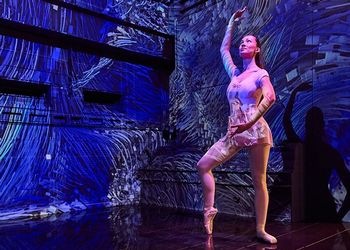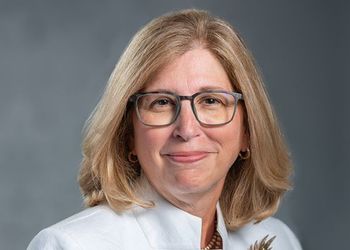Cover Story: Can an East Lansing-Mauritius Link Explain Internationalism at MSU?

After leading the nation in international studies and programs for a half century, MSU plots another 50 years of globally-focused teaching, research and outreach.
First, let’s stipulate. It’s impossible for a single person to be the proxy for what internationalism means at MSU. There simply are too many students and scholars, too vast a collection of research and outreach activities, and, especially evident in this 50th anniversary year for the campus international unit, far too much history for any one Spartan to suffice.
Still, you could do worse than start with Ravi Ammigan.
A communication manager for the Office of International Students and Scholars, Ammigan spends his workdays tending to the needs of MSU’s 4,000-strong international community. He’s also chipping away on a master’s degree in the College of Communication Arts & Sciences and working on a thesis exploring what motivates international students to come to study in the United States. And as a Mauritian citizen of Indian descent, Ammigan brings a decidedly global perspective to his MSU work and studies.
You’re forgiven if you’re a bit fuzzy on the location of Mauritius. For the record, the island nation is roughly half the size of Rhode Island and is located some 500 miles east of Madagascar in the Indian Ocean. Ammigan jokes that the U.S. Immigration and Naturalization Service is a bit fuzzy, as well. When he first received his recently updated INS work permit, the document mistakenly had him hailing from Mauritania, which, again for the record, is in northwest Africa—closer in fact to Ammigan’s adopted home of East Lansing than to Mauritius.
Yet the cheerful 28-year-old with a natty wardrobe and small soul patch beneath his lower lip seems unfazed by such geographic confusion, at least in small measure because of the vibrant international community he’s found at MSU.
“MSU has a strong international representation among its faculty, staff and students; a great tradition of international work; and a Big 10 reputation,” says Ammigan, explaining what attracted him to come work and study at MSU. “The university has it all.”
In the past year, MSU’s international programs have received more formal accolades, as well. In November 2005, MSU was named the top public university in the United States for study abroad according to Open Doors 2005, an annual report on international education. During the 2003-04 academic year, 2,269 MSU students studied abroad, second only to New York University among all colleges and universities.
In February 2006 the university received the Senator Paul Simon Award for Campus Internationalization for its efforts to expand globally focused research, teaching and outreach activities. The annual prize is named for the late Senator Paul Simon (D -IL), who identified international education as an issue of crucial importance for the future strength and security of the United States.
MSU students continue to rack up international achievements, as well. In March, MSU senior Timothy Howes was awarded a prestigious 2006 Churchill Scholarship to pursue graduate study at the University of Cambridge in Great Britain. Only 10 to 12 Churchill Scholarships are given annually. The awards cover all tuition and fees and also provide stipends for living expenses and travel. In recent years, MSU has led the public Big Ten universities in the production of Rhodes Scholars.
New internationally themed programs, particularly in the area of language instruction, have made headlines as well. In April, The Detroit Free Press covered news of a new federal grant to teach Arabic to Michigan K-12 and college students. Susan Gass, co-director of the MSU Center for Language Education and Research, “will help nail down the specifics on the Michigan project—where Arabic will be taught, how many students will take the class and how the grant will be doled out,” wrote Free Press reporter Emilia Askari.
One month later, the Michigan State University Confucius Institute was announced. In partnership with China’s National Office for Teaching Chinese as a Foreign Language and a major Beijing university, the MSU-based institute will provide online Chinese language courses for K-12 and adult learners in Michigan and around the world.
“Those who challenge themselves and take the online language classes will be setting themselves up for success,” declared The Detroit News in a May 11 editorial. “Few Americans know how to speak Chinese, but the demand is intense. The global economy and China's transformation into a market-oriented economy make a good case for studying the language.”
On any list of prominent people associated with the university’s international heritage, John Hannah surely must top the list. Hannah, who served as MSU president from 1941 to 1969, transformed the campus from a cozy regional college to a globally acclaimed research university. As part of this expansion, Hannah created the ISP unit.
“Hannah built on land-grant values when he called upon MSU to be global in thought and in action,” said then-MSU President Peter McPherson at the dedication of the John Hannah statue on September 17, 2004. “He made the world our campus, and named the nation’s first dean of international programs.”
Though proud of this heritage, current ISP acting dean Jeff Riedinger is more interested in laying the foundation for another half century of success—a task that starts with adapting the land-grant mission to the era of globalization.
“The new MSU Beijing office, for example, is akin to the county Extension office in the last century,” says Riedinger, echoing frequent comments made by MSU President Lou Anna K. Simon.
The office, which opened in spring 2006, will coordinate MSU’s education, research, technology transfer and Michigan-focused economic development activities in China. And like the model for Extension offices, which usually are funded in part by county governments and other public and private organizations, the Beijing office will be supported by a host of MSU partners. The Chinese government and the Hong Kong-based Sun Wah Education Foundation will cover some costs associated with the office.
Building the international future also means testing out the reputation of various MSU programs around the world. In his global travels, Riedinger has learned that several such programs are “world-class door openers,” including primary, secondary and higher education administration; food security; environmental science; nuclear physics; supply chain management; biofuels; packaging; and more.
Back in East Lansing, Riedinger is working with Provost Kim Wilcox to lead faculty, staff and students through a series of “Global Encounter” discussions to help shape MSU’s future international priorities. The first daylong event, held in the Breslin Center on April 20, attracted roughly 300 people from around campus.
“At the Summit, participants considered where we are currently engaged around the world, and contrasted that with what our profile should look like 10 to 20 years from now,” wrote Wilcox on his web site. “We received a wealth of substantive input in the strategic identification of countries, partners, and themes where MSU can have transformational impacts.”
Even as the university looks ahead, during the last few years, several people in the MSU community have gone to great lengths to document campus history, including early international engagements.
One is Keith Widder, longtime curator for the Mackinac Island State Park Commission and recipient of an MSU history Ph.D. in 1989. Widder won a 2006 Michigan Notable Book Award for Michigan Agricultural College, The Evolution of a Land-Grant Philosophy, 1855–1925, published by MSU Press. International nuggets in Widder’s book includes stories of the first international graduate of M.A.C. (Charles Georgeson, 1878, of Denmark), American graduates who took their M.A.C. training abroad (Edward Shelton, 1871, who worked as an agriculturist in Japan and Australia) and early partnerships outside of the United States (Robert Clute, 1896, helped to introduce a formal program of agriculture education in the Philippines, then a U.S. colony, in the early 1900s).
Additionally, emeriti agricultural economics professors Ken Verburg and Ray Vlasin are putting the finishing touches on a coffee table-type book of agriculture-centric history of MSU. As of June 2006, Verburg and Vlasin were racing to finish the book in time for Ag Expo 2006, which takes place July 18-20. The authors cull several international examples from MSU’s long history in agriculture, including extension service work in Pakistan, 4-H outreach in Belize and a concerted effort to build a viable coffee-growing industry in Rwanda.
“Several of the stories we came across are inspirational—really enough to make you cry,” says Verburg, surrounded by boxes of photos, documents, correspondence in the office he’s shared with Vlasin during the three-year book project.
Other recent books with strong international themes include Jay Rodman’s Global Focus: Images of a Land Grant Tradition, a compilation of winning entries from MSU’s annual international photo competition juxtaposed with archival and current images of the university’s international engagement; and Ralph Smuckler’s A University Turns to the World, which examines the growth of MSU’s international programs from 1956 until his retirement in 1990.
Threads of MSU international stories continue to captivate people today. For his graduate thesis, Ammigan is exploring the stories and messages that influence students abroad in their decision to come to MSU. Is it the mystique and prestige associated with a Big 10 school in the United States? The recommendation of a family member or friend near the university? Positive experience with MSU faculty, staff, students or alumni? Demonstrated commitment to internationally-oriented education?
Ammigan, who will begin gathering data for his thesis this fall, says that it’s too soon to tell empirically. However, each of these factors influenced his decision to come to East Lansing.
Realistically, it’s nearly impossible today to identify which themes will carry MSU to another 50 years of leadership in international education, research and outreach. Still, you could do worse than start with the goals of current MSU president Simon, first articulated during MSU’s 2004-2005 sesquicentennial celebration.
“By 2012, Michigan State University will be recognized worldwide as the United States’ leading land-grant research university,” Simon said in her September 8, 2005, sesquicentennial convocation address.
Indeed, land-grant has become world-grant. And as in 1855, MSU will lead the revolution.
For more information about MSU’s international programs, visit isp.msu.edu.
Geoff Koch is a media representative covering international programs for MSU University Relations. Write to him at kochg@msu.edu. Editor’s note: For information on the forthcoming book on the history of the College of Agriculture and Natural Resources, contact Laura Probyn at probyn@msu.edu.
TIMELINE OF MSU’S INTERNATIONAL ENGAGEMENT*
1855: MSU founded
1870s: First international students enrolled
1910: Cosmopolitan Club established for international and domestic students
1941: John A. Hannah becomes president
1943: Institute of Foreign Studies established
1944: First International Center opened
Early 1950s: Coordinator appointed to Foreign Agricultural Programs Office, precursor of Institute of International Agriculture, established in 1964
Canadian-American Studies Committee formed
1951: Technical assistance projects begun in Okinawa and Colombia
1953: Start-up of Brazil Project in Business Administration
1955: Start-up of Vietnam “Police and Public Administration” project
1956: Glen Taggart named first dean of International Programs (unit was renamed Office of International Studies and Programs in 1970)
1957: Start-up of Pakistan Project to create two rural development academies
1959: Community Volunteers for International Programs established
Late 1950s: Foreign Student Advisor’s Office established (later renamed Office for International Students and Scholars)
1960: African Studies Center established
Start-up of University of Nigeria, Nsukka Project
Early 1960s: MSU involved in planning and implementation of the U.S. Peace Corps
1961: Start-up of Taiwan Project at two Taiwanese universities
1962: Asian Studies Center established
1963: Latin American Studies Center established (later renamed Center for Latin American and Caribbean Studies)
Institute for International Studies in Education established (later renamed Office of International Education)
1964: Russian and East European Studies program established
Center for International Programs building completed
1969: Ralph Smuckler becomes dean of International Programs
1970: Office of Overseas Study established (Office of Study Abroad)
1972: Middle East Studies Committee established
1978: Women and International Development (WID) Program established
Western European Studies Program established
1980: First official MSU mission to the People’s Republic of China
Bean/Cowpea Collaborative Research Support Program established
The first International Extension Training Program offered through MSU Extension
1981: Center for Advanced Study of International Development established
1981–1982: “International Year” at MSU
1983: Volunteer English Tutoring Program established
1985: First of three major international Food Security Cooperative Agreements signed between MSU and USAID
1986: Foreign Teaching Assistant Orientation and Training Program established
1987: Institute of International Health established
1988: International Business Center established
1989: Japan Center for Michigan Universities established, with MSU as administrator for the fifteen Michigan public universities
1990: Center for International Business Education and Research established Internationalizing Student Life created
1991: Gill-Chin Lim appointed dean of ISP
Agricultural Biotechnology Support Project established
Visiting International Professional Program established
1992: Center for European and Russian Studies (now the Center for European and Russian/Eurasian Studies) created through merger of existing programs.
1995: John Hudzik appointed acting dean of ISP, becomes dean in 1998
LATTICE (Linking All Types of Teachers to International Cross-cultural Education) formed to help internationalize K–12 curriculum
1996: Center for Language Education and Research established
2000: Office of International Development established
MATRIX–The Center for Humane Arts, Letters, and Social Sciences Online involved in internet technology projects in developing countries
2003: Expanded International Center facilities become the Delia Koo International Academic Center
2004: MSU receives Goldman Sachs Foundation Prize for Excellence in International Education
2005: Jeffrey Riedinger appointed acting dean of ISP
2006: Fiftieth Anniversary of Office of International Studies and Programs
MSU receives the Senator Paul Simon Award for Campus Internationalization
MSU China Office opens in Beijing
*Condensed from timeline in Jay Rodman’sGlobal Focus: Images of a Land-Grant Tradition.
MSU GLOBAL FOCUS PHOTO CONTEST
Every year, the MSU Office of International Studies and Programs in cooperation with the MSU Alumni Association sponsors a photo contest. Last year’s alumni category winner was Barbara Sawyer-Koch, whose photo appears here.
The deadline for submissions to this year’s contest is Oct. 2. Eligible entries must be photos taken outside the U.S. The winning photos every year are displayed in the International Center and are published in ISP’s MSU International, as well as in a web gallery. For information on rules, guidelines and prizes, visit isp.msu.edu/photocontest.
TIMELINE BY DECADES
1960s: Major projects also included engineering in India, educational planning in Thailand, a college of agriculture in Argentina, national educational research and planning in Turkey, agricultural higher education in Indonesia, and food marketing systems in Latin America
1970s: Other major projects included: agricultural analysis in South Korea, agricultural production and marketing in Uruguay, agricultural education in Brazil, institute of agriculture and animal science in Nepal, communications in Iran, higher education in Ethiopia, and rural development in numerous countries in Africa, Asia, Latin America, and the Caribbean
1980s: Other major projects included: research on parasitic diseases in Sudan, agricultural research and planning in Senegal, higher education in Zimbabwe, agriculture in Burma, collaboration on teaching and research in Chile, agricultural extension in the Caribbean
1990s: Other major projects included: Afrobarometer (political research) in multiple African countries, social forestry education in Thailand, Third International Math and Science Study in many countries, research and analysis of NAFTA’s effects on Mexican farmers, Guinea Small Grants Staff Development and School Improvement Program, democracy training programs in Russia, Hungary, and Romania
2000s: Other major projects included: Partnership for Food Industry Development–Fruits and Vegetables with work in Guatemala, Kenya, and South Africa; Partnership to Cut Hunger and Poverty in Africa; Partnership for Enhancing Agriculture in Rwanda through Linkages; Linking Schools to Community Development in Vietnam; Education Reform Program in Egypt



